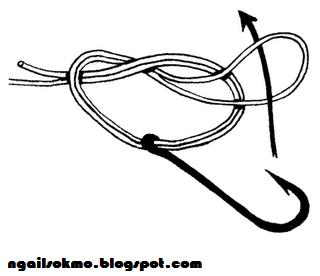Tali pancing adalah penghubung utama antara kita (pemancing) dengan ikan. Ia umpama talian hayat. Jika putus pertengahan jalan ketika bertarung kesudahannya pemancing akan kehilangan hasil dan rasa menyesal tanpa kesudahan. Seorang pemancing perlu memahirkan diri untuk membuat ikatan yang kemas dan kuat supaya tidak akan menjadi satu penyebab mendatangkan kegagalan.

Perlu diketahui simpulan dan ikatan adalah titik paling lemah pada tali pancing. Ada berpendapat ikatan mengurangkan sehingga 50% kekuatan sebenar tali. Bayangkan ini hanya ikatan belum termasuk ikatan yang terluka, calar, genting dan sebagainya. Kekuatan tali turun mendadak dan terlalu mudah putus ketika bertarung.Akhirnya, ucapan yang biasa didengar daripada mulut pemancing: “Huh! Besar betul ikan tu! Sampai tali 100 paun pun boleh putus dengan sekali tarik. Tentu puluh kilogram punya ikan.” Hakikat sebenarnya kalau ikan sekilogram memang mampu memutuskan tali 100 paun kalau ikatan tidak kemas atau longgar.
Ramai pemancing, tidak kira mereka baru atau lama tidak begitu mahir dan mengambil mudah mengikat tali pancing. Ikatan yang dibuat tidak kuat menyebabkan tali putus semasa berlawan dengan ikan. Lebih lagi jenis ikan yang kuat melawan dan membuat kejutan secara tiba-tiba di luar jangkaan kita.Tidak kira apa juga teknik ikatan anda gunakan untuk mengikat pancing, yang penting ialah kemahiran dan ketelitian ketika mengikat dan sebaik-baiknya bermula dari rumah.
Di rumah, kita ada masa dan boleh membuat ujian ikatan terhadap ikatan yang dilakukan tanpa tergesa-gesa. Ambil masa meneliti setiap ikatan yang di buat.Kemahiran ini perlu dikuasai dengan baik, sama pentingnya dengan pengetahuan mengenai pancing dan lain-lain.
ANIMASI IKATAN
Albright Knot - This knot is used to join two lines of different thicknesses. It is used to attach a heavier 'leader' (rather than a double) to a lighter main line. It requires careful forming of the loops.
Blood Bight Knot - This knot is used to create drop loops in light line traces. Its advantages are that the dropper tends to stand out from the main line and it's reputed 95% retained breaking strain.
Blood Knot - This is a high strength knot to join two similar thicknesses of line. It's main advantage is it's low profile enabling it to run smoothly through rod line guides.
Butterfly Dropper - Quick and easy to tie. Creates a loop that will stand away from main line. Is most suitable for lines over 15 kilo. Can slip if not tightened properly.
Centauri Knot - This knot is principally used to attach hooks through the eye to the line. Works well on a wide range of line strengths and claims to retain 96% of breaking strain.
Clinched Half Blood - This is a high strength multi purpose knot. It's main use is attaching swivels,lures or hooks to the main line. Formation should be assisted by pulling down to the base.
Dropper Loop - Creates a stand out loop for attaching a hook to a trace. Handy in that it can be tied anywhere along the line.
Drop Loop - This is a high strength loop for the main line. It's main use is to form a loop for attaching sinkers to the main line.
Flemish Eye - Is the best method to attach hooks to multi strand wire. Its looseness acts like a spring and takes the pressure off the crimped sleave.
Half Blood Knot - This is a high strength multi purpose knot. It's main use is to attach swivels, hooks and lures to the main line. Assist the formation by pulling down on the roll towards the base.
Hook Snell - Quick and simple method of attaching line to a hook with an up or down turned eye. Can only be used with a free length of line as both ends must pass through the eye.
Hook Snood - This is a high strength knot to attach trace line to a hook. It's main advantage is the hook will lay along the direction of the line.Note that the length of the trace will be the length of the loop.
longliners Knot - For attaching a hook line to a continuous heavy main line. Will not slip up or down the line
Perfect loop - One of the better loop knots and can be used on lighter lines although best suited to the heavier. It will not kill the action of the lure or fly. Function: Connecting lures or fly to heavy leader, trace or shock tippet.Strength: Retains 70+ strength
Spider Hitch - A relatively easy method to create a double. May require some practice to feed the loops progressively off the thumb when forming. Reputed to retain 80% strength.
wivel to Double - Attaches a swivel to a double with the double remaining intact.
Thumb Knot - A knot useful for attaching hooks and rings to heavy line. May require some practice to sequentially ease the loops off your thumb.
Turle Knot - A snare knot that is used to tie a hook to a light leader.
Uni Knot - This versatile knot can be used can be used for connecting hooks, swivels, rings and lures. Its main advantage is that it retains virtually 90% breaking strain. Easy to tie even in the dark after practice.
Wind on Wire Leader - A fairly simple join which enables reasonably long plastic coated wire traces to be wound up through the rod guides. Can be used for casting lures.
Sumber :
http://www.scubadivecharters.com
http://pancingngail.blogspot.com



























0 comments:
Post a Comment